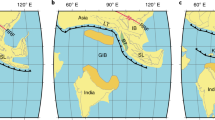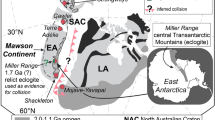Abstract
ON the basis of the positions of the magnetic south pole in the Triassic determined by palaeomagnetic studies of African and South American rocks, Creer1 has argued that the drifting apart of Africa and South America began in the Permian. Briefly, if South America and Africa are placed in such a position that their Palaeozoic polar wandering curves coincide, there is obtained a reconstruction very similar to that suggested by the shapes of the coastlines, and the earliest palaeopoles which do not coincide are those of the Triassic. In this argument, the Triassic palaeopole for South America was computed from a study of the lavas of the Serra Geral formation, in the southern part of Brazil. Unfortunately, a radiometric study2 of forty-one samples of basalt and dacite has shown that the principal phase of this igneous cycle is of Middle Cretaceous age, about 115–125 m.y.
This is a preview of subscription content, access via your institution
Access options
Subscribe to this journal
Receive 51 print issues and online access
$199.00 per year
only $3.90 per issue
Buy this article
- Purchase on Springer Link
- Instant access to full article PDF
Prices may be subject to local taxes which are calculated during checkout
Similar content being viewed by others
References
Creer, K. M., Nature, 203, 1115 (1964).
Amaral, G., Cordani, V. G., Kawashita, K., and Reynolds, J. H., Geochim. Cosmochim. Acta, 30 (1966).
Valencio, D. A., I Vas. J. Geol. Argentinas (in the press).
Fisher, R. A., Proc. Roy. Soc., A, 217 (1953).
Briden, J. C., Nature, 215, 1334 (1967).
Creer, K. M., Nature, 219, 41 (1968).
Creer, K. M., in Mantles of the Earth and Terrestrial Planets (edit. by Runcorn, S. K.), 351 (Interscience, 1967).
Creer, K. M., J. Geomag. Geoelect., 13, 3, 4 (1962).
Creer, K. M., Phil. Trans. Roy. Soc., 258 (1965).
Briden, J. C., J. Geophys. Res., 73 (1968).
Graham, K. W. T., and Hales, A. L., Geophys. J., 5, 318 (1961).
McElhinny, M. W., and Opdyke, N. D., J. Geophys. Res., 73, No. 2 (1968).
Opdyke, N. D., J. Geophys. Res., 69, 2477 (1964).
Gough, D. I., and Brock, A., J. Geophys. Res., 69, 2489 (1964).
Opdyke, N. D., J. Geophys. Res., 69, 2495 (1964).
Brock, A., J. Geophys. Res., 73, No. 4 (1968).
Briden, J. C., Geophys. J. Roy. Astro. Soc., 12, 375 (1967).
Gough, D. I., and Opdyke, N. D., Geophys. J., 7, 457 (1963).
Author information
Authors and Affiliations
Rights and permissions
About this article
Cite this article
VALENCIO, D., VILAS, J. Age of the Separation of South America and Africa. Nature 223, 1353–1354 (1969). https://doi.org/10.1038/2231353a0
Received:
Revised:
Issue Date:
DOI: https://doi.org/10.1038/2231353a0
This article is cited by
-
Pachypteria sinaitica n. sp. - eine aufgewachsene, austernähnliche muschel aus dem unterkarbon Ägyptens
Paläontologische Zeitschrift (1983)
-
Palaeomagnetism of some Middle Jurassic Lavas from South-east Argentina
Nature (1970)
Comments
By submitting a comment you agree to abide by our Terms and Community Guidelines. If you find something abusive or that does not comply with our terms or guidelines please flag it as inappropriate.



